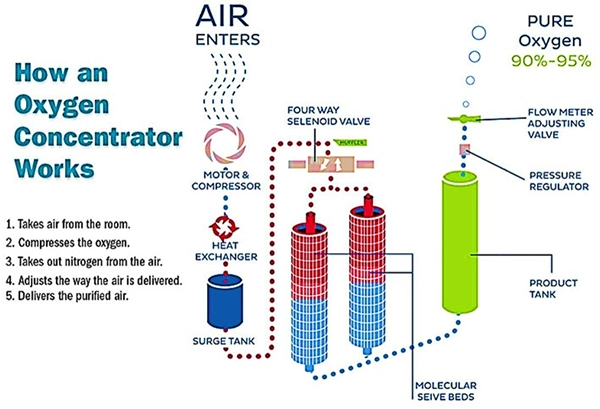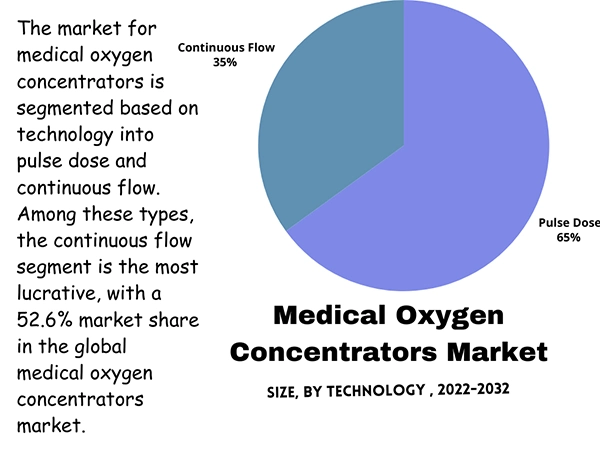
Being an innovative medical device, modern oxygen concentrators in MedTech are revolutionizing the health game.
From respiratory illness, COPD, and heart disease, to bronchitis, they might be the one-stop solution to look for. In other words, with this tech-driven device, patients can manage their own respiratory care at home.
Two years ago, there was a wave in the global portable oxygen concentrators market, which was estimated at US$ 1.9 billion.
Since then, the demand for this modern machine has only been on the rise. From hospitals to homecare settings, oxygen concentrators are a blessing to all.
Till then, with this guide, know the ins and outs of these devices. We meant an innovative technology behind modern oxygen concentrators, and make your mind get your hands on it. Also, learn about Role of Technology in Advancing Well-Being by reading this article.

The air you inhale is made up of about 20% oxygen. Comparatively low for people with breathing or respiratory diseases.
Oxygen concentrators draw and concentrate the oxygen level present in the air and refine it to 90%-95% oxygen in return.
In need of higher oxygen concentration than the levels of ambient air, this facility in your homecare setting is a game changer.
Also, it has grabbed the doctor’s attention. Many of those prescribe it to patients with asthma, lung cancer, flu, COVID-19, sleep apnea, heart failure, and cystic fibrosis.
Today, more than 1.5 million Americans are using an oxygen concentrator for supplemental oxygen therapy either by renting it or getting one.
If yours too shows a green flag, or you get your doctor’s OK, go get it!
For any reason you need it, you can check Inogen One g4 price at MainClinicSupply store.
A portable device, especially health-related gear makes life much easier. Since they are more lightweight and compact than ever. They are just built smaller.
Some available in the market are small enough to be carried in a shoulder bag. They run on a rechargeable battery and weigh between 2 and 20 pounds.
Even home versions of oxygen concentrators can be used when running errands or while traveling.
Usually, a low-flow travel concentrator supplies 0.5-5 liters of oxygen per minute whereas a high-flow machine supplies 10 liters per minute.
This encourages patients to take a step out and pursue active lifestyles, managing their respiratory care simultaneously.
On what parameters can you claim that modern oxygen concentrators are smart enough? Most probably, the capability to monitor the progress of oxygen therapy.
With this device, you can evaluate the breathing rates of the patient and adjust accordingly. For instance, when the patient is asleep, you can adjust the flow as the patient’s breathing rate decreases.
Wireless connectivity ends up with patients operating it directly from their phones using apps.
Remote monitoring stores respiratory care data to analyze the respiratory status of both patients and doctors.
To name its components, it is made up of a control, filters, air inlet, waste outlet, and flow splitter. The control panel comprises a power switch, oxygen cock, and valve for adjustment below.
For filters, the concentrator contains a series of filters. Those are arranged in order, i.e. external coarse, pre-filter, and inlet filter (0.1 μm).
The compressor (20 PSI), heat radiator, 4-way solenoid-controlled valve, sieve canisters with zeolites (have an average lifespan of 60,000 h), pressure equalization valve, check valve, pressure level regulator, product canister, outlet filter (0.3 μm), and flow meter contribute to letting it do its job properly.

The moment you switch on the oxygen concentrator, it drives indoor air by means of filters (as mentioned right above) attempting to eliminate particles, germs, and other impurities.
In the first stage, it pumps air into one of the two cylinders, then nitrogen is removed to throw pure oxygen along with other gasses present in indoor air.
The second stage is all about cylinders being reverted in a scheduled loop, ensuring the patient receives a steady oxygen supply.
In essence, oxygen is applied in continuous flow dose and pulse mode distribution.
Presently, the continuous flow dose segment is the most lucrative, with a 65% market share in the global medical oxygen concentrators market.

Mostly employed in the medical profession. Here are some circumstances when oxygen concentrators are put into use:
To conclude, oxygen is a vital medical drug required by patients in less severe to highly severe cases.
Advances in technology, incorporated into modern oxygen concentrators, free respiratory patients from their homes and encourage them to live the active lifestyles they deserve.
Smaller units, smarter technology, and more durable designs contribute to enhancing the patient experience.
